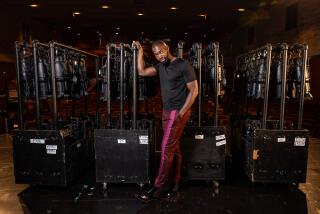Merce goes deeper
WAITE PARK, MINN. — The rainbow quarry -- with its mammoth, magnificent 150-foot rock walls -- lies 70 miles northwest of Minneapolis. To get to it, you pass by Granite City Counseling, and some might say that Merce Cunningham needed just that for undertaking perhaps the most impractical and magnificent production of his career in his 90th year. Thursday night, his Merce Cunningham Dance Company made an “Ocean” in the quarry.
It had help, of course, and lots of it, to put on this breathtaking 90-minute 1994 work, which was danced in the round and accompanied by an orchestra of 150 musicians surrounding the audience on the top row of circular bleachers, in a breathtaking site where giant machines normally wrest away giant slabs of rock.
Access roads were built by Martin Marietta Materials, which owns the quarry and which surprised everyone by its enthusiastic support for the project (the dress rehearsal Wednesday night was given for muscular stonecutters and their families). The St. Cloud Symphony, from the neighboring town, was bolstered by musicians from four colleges in the area. The Walker Art Center in Minneapolis, which sponsored the event as the opening of its performing arts season, needed a convoy of buses to ferry an audience of 1,200 in and out. The College of St. Benedict and the University of Minnesota also had a hand in the making of the event, which had a budget of about $1 million.
The shiny, skintight costumes had been accidentally shipped to London, and dressmakers in New York had to work around the clock to sew new ones and ship them to Minnesota. Then, on a wet day, the rain gods needed enticing to keep the site dry for the performance. Cunningham said that the morning of the performance he watched what looked like a waterfall from the window of his hotel room.
But, apart from some drizzle, the weather held. And the spectacle of extraordinary dancers in silky sea-green, bright orange and deep purple body suits evoking exotic sea creatures and surrounded by jagged, jutting, primordial mountains of granite -- all the while enveloped in foaming waves of sound -- made everything worth it.
Originally staged in a charming 19th century circus building in Brussels, and since then occasionally mounted in tents, amphitheaters and other circular venues, “Ocean” is Cunningham’s glorious tribute to his longtime collaborator, John Cage, who died in 1992. Cage had greatly admired James Joyce and got the idea for “Ocean” from the mythologist Joseph Campbell, who once told him that Joyce had planned to write about the sea as a follow-up to “Finnegans Wake.”
Neither Joyce nor Cage lived to accomplish their watery notions. But Cunningham soldiered on. He commissioned Cage’s assistant Andrew Culver to write an orchestral score, “Ocean 1 -- 133,” using Cage’s indeterminate compositional methods, and David Tudor to contribute aqueous electronic music, much of it suggesting startlingly weird depth charges and oddball creatures, to be projected from speakers above the stage.
Cunningham’s dance has the fascination of an underwater dive. Ninety minutes is a long sit for an abstract work in which nothing repeats and nothing is predictable. And Cunningham doesn’t obscure the slow passage of time. Digital clocks face the audience, ticking off the seconds.
But that only makes the sensation of an oceanic adventure all the more realistic. A chronograph is a diver’s lifeline because one experiences time differently when submerged. Underwater, one is alone with one’s senses. You bear your own wondrous or terrifying witness.
That, the wondrous part, is what happens in “Ocean.” With dance and music in the round, everyone sees and hears something different. You notice the instruments closest to you, while the rest contribute an amorphous, ever-changing drone. The shapes you see also depend upon where you sit.
A single dancer begins and ends the work. In between, thousands of gestures and different ways of combining the company of 14 occur. Every now and then, something might have a point of reference -- say a circle of dancers in a Matisse painting falling to the ground. But seeming arbitrariness, executed with astonishing virtuosity, is what holds one’s attention.
“Ocean” gets more complex as it goes along, with more intricate combinations and more varieties of speed. But none of this is regular. Everything is continually in flux, and on Thursday that included the lighting onstage and of the quarry itself.
For most of the evening, the granite loomed as dark and mysterious shapes, creating a cavernous atmosphere. But sometimes a section of rock was illuminated as if a diver’s light had been directed toward it. Near the end of the evening, huge expanses of granite wall were lighted just to remind us how small we all were. By then, the temperature had dropped. Minnesotans came prepared with down coats, wool hats and mittens. The dancers had a heated stage. But most out-of-towners were shivering, and the musicians on high had the worst of it. Ninety minutes in an arctic clime wreaks havoc with intonation.
The Minneapolis Star Tribune reported Thursday that the performances, scheduled to end tonight, would be the last time “Ocean” would be mounted. But the company says that is not so: A staging in Barcelona, Spain, is planned, and there have been talks with the Los Angeles Music Center to put “Ocean” on in Walt Disney Concert Hall, which is a natural venue for it. In the meantime, Charles Atlas, who has made a number of impressive films of Cunningham’s work, had a large setup in the Rainbow Quarry, documenting the performance for a forthcoming DVD.
--
More to Read
The biggest entertainment stories
Get our big stories about Hollywood, film, television, music, arts, culture and more right in your inbox as soon as they publish.
You may occasionally receive promotional content from the Los Angeles Times.











